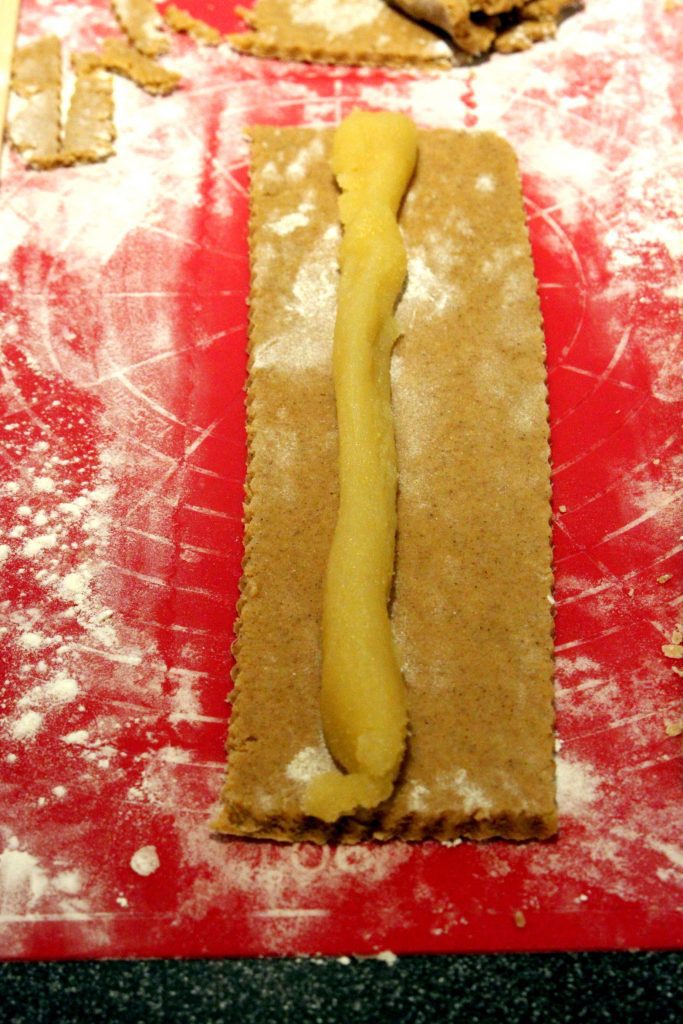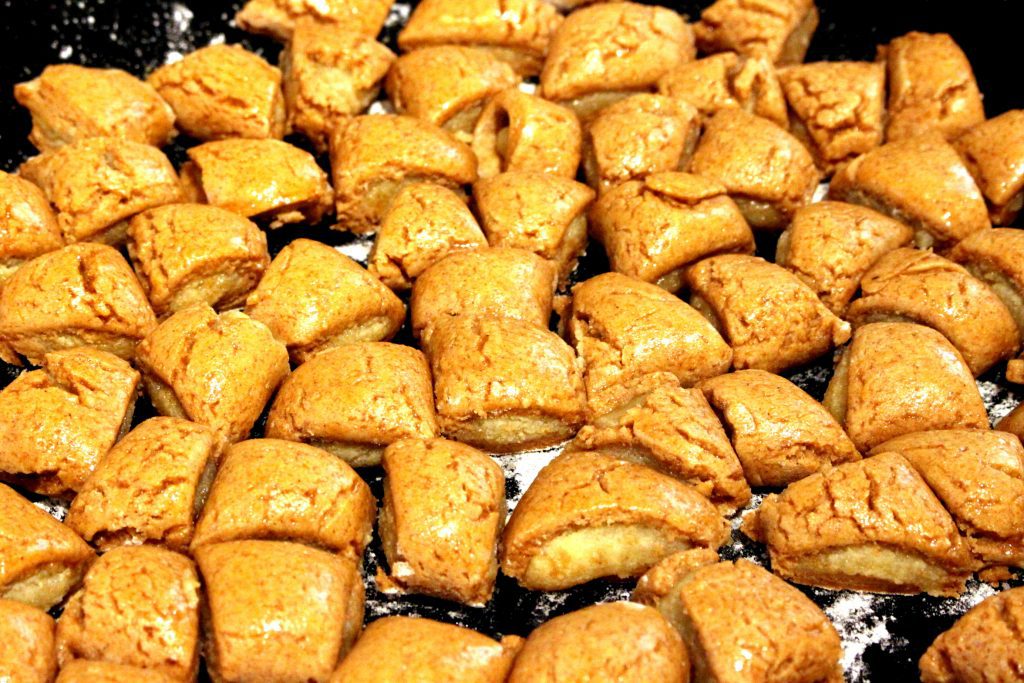Weil ich schon ewig diese Biberli machen wollte. Ich hab’s nie gewagt, aber sie immer fertig gekauft. Wir lieben sie sehr und bei uns gehoeren sie einfach auf den Weihnachtstisch! So, nun hab ich mich dran gewagt und es war gar nicht so schlimm.
Biberli sind Lebkuchenaehnliche kleine Gebaeckstuecke, die mit einer Mandelpaste gefuellt sind. Sie schmecken sehr weihnachtlich und passen wunderbar in diese kalte und festliche Zeit. Ich kann sie schlecht beschreiben, aber wer sie einmal gegessen hat, kann nicht mehr damit aufhoeren!
Die Biberli sind eine mundgerechte Ableitung des Appenzeller Biberfladens. Erstmal nachweislich gebacken wurde er im 16. JH. Aber eigentlich wurden schon frueher aehnlliche Fladen in ganz Mitterleuropa hergestellt und die ersten schweizerischen Bibenzelter (Baecker) finden sich in Basel und Zuerich schon im 14. JH. Interessant ist auch, warum diese Fladen Biberfladen heissen!
Das Wort Biber hat nichts mit dem Tier zu tun. Es ist eine Veraenderung des Wortes Bimenzelte, bimen(t) stammt aus dem Lateinischen pigmentum zurueck, was Nelkenpulver bedeutet. Zelte(n) ist ein flaches Gebaeck, wie ein Fladen.
************
I always wanted to make the Biberli, but never dared. So I always bought them from the store. We love them very much and they are a staple on our Christmas table. So, now I dared to make them and it was not hard at all!
Biberli are gingerbread type pastries or cookies, filled with an almond paste. They are very Christmassy and are perfect for this cold and festive time of year. I cannot describe them, you just have to try! But I can assure you, once you start eating them you cannot stop!
The Biberli are small pieces of pastry derived from the big Appenzeller Biberfladen. As it is a Swiss traditional pastry it is known since the 16th century. But actually it is known in some parts of Europe these kind of cakes have been baked in Basel and in Zurich since the 14th century. It’s also interesting, why it’s called Biberfladen!
The word Biber has nothing to do with the animal Biber. (beaver) The real word would be Bimenzelte, bimen(t). It’s derived from the Latin word pigmentum which means clove (the spice). Zelte(n) is a flat pastry.

Fuer ca 80 Stueck:
200 g Honig
175 g Zucker
3 EL MiLch
1 Ei
1 Eigelb
1 TL Vanillezucker
1 TL Zimt
1/4 TL Ingwer
1/4 TL Nelkenpulver
1/4 TL Kardamon
1/4 TL Muskatnuss
1/2 TL Coriander
500 g Ruchmehl
1/2 TL Backpulver
Fuellung:
Man kann bei der Migros Mandelfuellung kaufen, die ist wirklich sehr gut.
oder man macht seine selbst:
200 g geschaehlte, gemahlene Mandeln
3 EL Rosenwasser
2 Tropfen Bittermandelaroma
80 g Zucker
120 g Honig
1 verquirltes Eiweiss
Alle Zutaten zusammen mischen, sie sollte wie Marzipan werden. Falls die Fuellung zu weich ist, etwas mehr Mandeln zugeben.
Glasur:
3 EL Wasser
2 TL Speisestaerke
3 EL Honig
Fuer den Teig:
Honig, Zucker und Milch zusammen erwaermen und kurz zum Kochen bringen. Das Ei und das Eigelb verschlagen, dann Vanillezucker und alle Gewuerze zugeben und vermischen. Dann alles zur Honigmischung dazu geben. Das Mehl mit dem Backpulver vermischen und dann in die Masse geben und leicht verkneten. Den Teig flach druecken und in Klarsichtfolie verpackt im Kuehlschrank mindestens 40 Minuten kuehlen.
Danach den Teig in drei Teile schneiden und jedes Teil ca 4 mm duenn auswallen. Den Teig in ca 7-8 cm breite, lange Streifen schneiden, ich habe das mit dem Raviolirad gemacht. Die Fuellung in fingerdicke Rollen formen, das macht man am Besten in einer Klarsichtfolie, da die Fuellung sehr klebrig ist. Diese Rollen auf die Mitte der Teigstreifen legen, die Raender des Teiges mit kaltem Wasser bestreichen und den Teig um die Fuellung rollen. Dann die Biberli wie Dreiecke schneiden und auf ein bemehltes Backblech legen. Ueber Nacht trocknen lassen. (Nicht im Kuehlschrank!)
Dann die Biberli mit etwas Milch bestreichen und im vorgeheitzten Ofen bei 160 C Grad 20-25 Minuten backen.
Fuer die Glasur das Wasser mit der Speisestaerke mischen und aufheitzen, Honig zugeben und gut vermischen. Die noch warmen Biberli damit bestreichen. Gut trocknen lassen.
In einer Dose lassen sich die Biberli gut 3-4 Wochen halten, doch meist sind sie schon vorher gegessen!
************
For approx. 80 Pieces:
200 g Honey
175 g Sugar
3 tbsp Milk
1 Egg
1 Egg-yolk
1 tsp Vanilla Sugar
1 tsp Cinnamon
1/4 tsp Ginger
1/4 tsp ground Cloves
1/4 tsp Cardamom
1/4 tsp Nutmeg
1/2 tsp Coriander
500 g Flour
1/2 tsp Baking Powder
Filling:
If you live in Switzerland you can buy a readymade filling in Migros
or you make it yourself:
200 g peeled, ground Almonds
3 tbsp Rose Water
2 Drops Bitter Almond Essence
80 g Sugar
120 g Honey
1 Egg-white, beaten slightly
Mix all ingredients together. It should get similar to marzipan. If it is too soft add more ground almond.
Glaze:
3 tbsp Water
2 tsp Cornstarch
3 tbsp Honey
For the dough:
Put honey, sugar and milk in a small pot and heat it up, bring to a boil, take from the heat. Beat the egg and egg-yolk, add vanilla sugar and all seasoning and mix well. Add it to the honey mixture. Mix the flour with the baking powder, then mix it all together and knead it to a dough. Form a flat cake from the dough and wrap it into cling-foil. Refrigerate for at least 40 minutes.
Then cut the dough into 3 pieces and work with each piece. Roll it out to a long rectangle about 4 mm thick. Cut this into a long approx. 7-8 cm wide stripe. I cut them with the ravioli wheel. Roll the filling into long, finger thick rolls, this is best done in a cling-foil as the filling is very sticky. Put those rolls into the middle of each dough stripe. Brush the edges of the dough with cold water and roll them up over the filling. Then cut triangles from the rolls. Put them onto a floured baking tray. Let them dry on the baking tray overnight. (do not refrigerate them!)
Brush the Biberli with cold milk and bake them in the pre-heated oven at 160 C for 20-25 minutes. For the glaze dissolve the cornstarch in the water and heat it up, then add the honey, mix well. Brush the warm Biberli and let dry well.
You can keep the Biberli in an airtight tin for 3-4 weeks, but I assure you, they will be eaten far before that!












Und hier sind weitere Weihnachtsplaetzchen Rezepte:
Here are more Christmas Cookie recipes:
Haselnuss Makroenli
Eierlikoer Zuendhoelzli
Mocca Schneebaelle
Spekulatius Kekse
Engadiner Guetsli
Schwarz-Weiss Sable
Chrischttoertli






![Validate my RSS feed [Valid RSS]](https://pane-bistecca.com/wp-content/uploads/2024/05/valid-rss-rogers.png)